In the autumn season, nature paints the landscape with radiant red, orange, and gold colors. The best time to observe tree and plant seasonal changes across the United States begins when cool weather combines with the fresh air of autumn. The beauty of fall leaves awaits you whether you enjoy tranquil forest walks or scenic mountain drives. Here are the top ten destinations to witness the stunning seasonal transformations in nature.
Blue Ridge Parkway: Experience the Blue Ridge Parkway as you travel its Dynamic Mountain Range.
Travelers along the Blue Ridge Parkway between North Carolina and Virginia experience an exceptional view of autumn foliage. Travelers driving along the scenic highway through the Appalachian Mountains can enjoy panoramic views of rolling hillsides painted in vibrant colors. Visitors see maples, oaks, and birches transform into brilliant red and yellow colors. Widely distributed wildflowers, including asters and Goldenrods, bring bursts of color to the forest floor right alongside the golden foliage. Close-up autumn beauty awaits hiking enthusiasts on trails at Craggy Gardens and Humpback Rocks. Native plants like Trillium and Foamflower thrive in the Parkway's cool shade found within Appalachian woodlands.
Acadia National Park: Autumn on the Coast
Acadia National Park combines Maine's coastal landscapes with forested regions, which undergo stunning transformations during the fall season. The park's forests of sugar maples, beeches, and birches change into vibrant orange and golden colors, which contrast sharply with the park's rocky shores and deep blue Atlantic waters. As the first rays of sunlight touch the sky, Cadillac Moun, the tallest peak along the East C, offers breathtaking sunrise vistas across the vibrant fall foliage. Native perennial plants like Blue Flag Iris occupy the park's marshy areas and add year-round textural interest to the landscape.
Great Smoky Mountains: The Great Smoky Mountains display an array of brilliant colors that look as though they were painted directly from an artist's palette.
During autumn each year, the Great Smoky Mountains National Park, which lies between Tennessee and North Carolina, attracts millions of visitors, making it one of America's most popular destinations. People who visit the Smokies will marvel at the beautiful fall colors of sweetgum trees, together with red maples and yellow birches. Visitors to Newfound Gap Road who ascend to Clingmans Dome encounter breathtaking panoramic views as the foliage stretches past the horizon. Wild ginger and other native plants flourish in the park, and intrepid explorers find delight in it because they maintain healthy green leaves throughout the season when the trees around them change appearance.
Vermont’s Green Mountains: A Fall Wonderland
Vermont's Green Mountains stand as a premier location to witness fall foliage, which links the state to this seasonal wonder. Route 100 winds through charming villages and undulating hills, which exhibit brilliant hues from sugar maples and oak trees. Take in the cool autumn breeze by walking across covered bridges or hiking trails such as Camel’s Hump. Throughout the area, forest undergrowth displays the delicate beauty of native plants like Goat’s Beard, which creates a layered tapestry of fall splendor.
Aspen in Colorado demonstrates The Rockies' Golden Glory.
The common fall color palette of reds and oranges fails to depict Aspen, Colorado, which results in a one-of-a-kind visual experience. The aspen trees at Aspen become brilliant yellow displays that stand out sharply against the dark green of neighboring evergreen forests. The renowned Maroon Bells landscape in Colorado becomes more enchanting when its surroundings transform into golden leaves. The meadows at high altitudes burst into bright yellow displays from wildflowers like Goldenrods that bloom during the late Goldenrod season.
Shenandoah National PGoldenrodinia’s Autumn Paradise
Visitors from Washington, D.C, can experience nature’s autumn splendor at Shenandoah National Park because it lies just 75 miles away. People who explore outdoors can walk the Old Rag or Hawksbill Summit trails to experience colorful foliage up close. Black Coho grows in the park alongside its native species, with its white blossoms contrasting against dark green leaves during the warm hues of autumn.
The Berkshires: A New England Treasure
Massachusetts’ Berkshire Mountains attract visitors during autumn due to their combination of cultural sites and breathtaking natural views. Maples, oaks, and birches paint Berkshires’ hillsides with vibrant colors, creating ideal conditions for leaf-peeping. The Mohawk Trail invites drivers to tour its beauty, while Mount Greylock offers hiking adventures at Massachusetts' highest point. Blue Lobelia, along with other native perennials, thrives in the region's moist, shaded areas while different plant species extend along the trail.
Columbia River Gorge: A Pacific Northwest Gem
The Columbia River Gorge on the Oregon-Washington border displays beautiful waterfalls, cliffs, and vibrant autumn forests. Bigleaf maples alongside vine maples and cottonwoods transform the landscape into a shifting yellow and orange red tapestry. Crown Point and Multnomah Falls provide breathtaking views that make autumn excursions unforgettable. Maidenhair Fern are native perennials that thrive in the shaded and moist regions of the gorge.
Upper Peninsula, Michigan: A Colorful Escape
Fall leaf enthusiasts will find the Upper Peninsula of Michigan a hidden gem. The untouched forests and gleaming lake here establish a peaceful environment for enjoying life. Scenic drives near Lake Superior and hiking trails in Porcupine Mountains Wilderness State Park allow visitors to witness breathtaking seasonal transformations. White Trillium, among other native plants, provides year-round forest beauty because they bloom in spring and maintain green foliage under hardwood trees during every season.
The Ozarks: Autumn in the Heartland
The Ozark Mountains stretch across Arkansas and Missouri, where rugged terrain transforms into vibrant fall colors. Oak trees dominate the region's forests with companionship from hickories and maples, which change to radiant reds, oranges, and yellowsThe bestst fall scenery in the Ozarkis showcasedes along The Pig Trail Scenic Byway and hiking paths through the Buffalo National River region. Wild Columbine, among other native perennial species, adds red colors to rocky areas and attracts pollinators when the season ends.
Embrace the Magic of Fall
The fall season ends swiftly, but its beauty remains in the memories of people who take time to experience this lovely part of the year. As the leaves change colors and autumn winds cool the air, we are drawn to slow down and connect with nature while we explore the Rocky Mountains and New England's peaceful woods. When you explore these magnificent landscapes, take time to observe how native perennials and plants create depth and texture, which results in a sensory experience. Autumn leaves display nature's artistic power, which brings happiness during seasonal transformation, and this natural splendor delights people no matter if they hike mountains or drive through scenic routes.
The Most Striking Fall-Foliage Trees and How to Identify Them
Certain trees dominate landscapes in autumn with vivid orange, red, and yellow displays. The bright colors are a beautiful sight for those who walk by and mark nature's repeating pattern while trees prepare for winter dormancy. Among the vast array of species that create stunning fall foliage displays, only a few specific trees receive continuous praise. This guide showcases beautiful autumn-colored trees while advising on spotting them in your neighborhood, at a local park, or during countryside drives.
1. Sugar Maple (Acer saccharum)
Why It's Special:
The sugar maple is the ultimate emblem of autumn seasonality. A single tree's canopy can simultaneously display leaves that transform into brilliant yellow, orange, and scarlet shades. Depending on its geographic location and climatic conditions, this tree's dramatic color change starts between early and mid-autumn.
How to Spot It:
Leaf Shape: The sugar maple leaf has five lobes separated by softly rounded indentations. The spaces between the lobes of the sinuses maintain a smooth texture that forms a U-shape.
Bark: As the tree matures, its bark turns grayish-brown, forming long, irregular plates that may curl at their edges.
Other Clues: This species, which is frequently tapped for maple syrup production, can be identified by the presence of sugar shacks or spiles in regions where it grows abundantly.
2. Red Maple (Acer rubrum)
Why It's Special:
The aptly named red maple transforms from deep green to a near-solid red throughout several weeks in autumn. Although its leaves occasionally exhibit yellow or orange tones, they are best known for their vibrant red color.
How to Spot It:
Leaf Shape: The standard red maple leaf contains three primary lobes, which occasionally expand to five and feature sharp V-shaped indentations between each lobe. Leaf stems and twigs on this plant exhibit a reddish coloration well before the autumn season begins.
Bark: While young bark remains smooth and light gray, it develops cracks as it ages. As trees age, they show ridges and dark surface patches while maintaining a gray tone.
Other Clues: Red maples naturally grow along water sources and in low areas, but people plant them in cities and suburbs because they adapt well to different environments.
3. Japanese Maple (Acer palmatum)
Why It's Special:
Gardeners worldwide favor the Japanese maple for its intricate leaves with delicate lobes. These trees' leaves display a spectrum of fall colors, from light yellow to deep burgundy, that varies with different cultivars. Japanese maples' graceful year-round silhouette results from their small size and sophisticated branching structure.
How to Spot It:
Leaf Shape: Japanese maples showcase palm-shaped leaves, which typically divide deeply into seven or nine sections.
Size: Japanese maples grow shorter than many native maples, ranging from 6 to 15 feet, but some specimens reach greater heights.
Other Clues: These plants are frequently planted as ornamental features in landscaped gardens, and you will usually see them adjacent to patios or walkways. They serve as prominent features in rock or Zen-style gardens.
4. Ginkgo (Ginkgo biloba)
Why It’s Special:
The ginkgo tree is a living fossil because it has existed for millions of years. When fall arrives, its fan-shaped leaves transform into an almost glowing radiant yellow before simultaneously dropping to form a golden ground cover.
How to Spot It:
Leaf Shape: The leaves of the ginkgo tree are fan-shaped, with light veins branching out from their central stem. The leaves resemble scallop shells, with occasional notches in the center.
Branching Pattern: The branches often appear in ascending layers.
Other Clues: Municipal planners often choose ginkgo trees for street and park plantings. Female ginkgo trees generate fruit with an unpleasant odor, which leads to the use of male cultivars in most urban plantings to prevent this smell.
5. Quaking Aspen (Populus tremuloides)
Why It's Special:
Quaking aspens are some of the most widespread trees throughout North America. Its leaves display brilliant yellow hues every autumn, and massive aspen groves create dazzling golden waves that transform entire hillsides in mountain regions.
How to Spot It:
Leaf Shape: The quaking aspen features small round leaves with serrated edges connected to flattened petioles, enabling them to tremble even in the slightest breeze.
Bark: The bark appears smooth and pale, presenting white to greenish shades with occasional black scars or markings.
Other Clues: A single root system gives rise to multiple aspen trees growing together in large colonies.
6. Sweetgum (Liquidambar styraciflua)
Why It's Special:
The tall, stately tree displays a kaleidoscope of fall colors, including yellows, oranges, purples, and reds, often appearing together on a single branch. Thanks to the star-shaped leaves, autumn displays become more enchanting.
How to Spot It:
Leaf Shape: Star-shaped leaves have five to seven pointed lobes.
Bark: Older sweetgum trees develop a grayish bark that becomes deeply furrowed and rough.
Other Clues: The distinctive spiky seed pods of sweetgum trees measure the size of golf balls and become apparent after leaves fall because they either hang from branches or scatter across the ground.
7. Dogwood (Cornus spp.)
Why It's Special:
Dogwood species and cultivars are admired for their stunning red to purplish-colored leaves during the fall season. While dogwoods bloom with spectacular blossoms during spring, they create a visually stunning autumn display of colorful leaves and bright red berry clusters.
How to Spot It:
Leaf Shape: Oval dogwood leaves display smooth edges, curving veins, and a pointed tip.
Bark: The species determines whether bark is flaky or smooth yet commonly shows a layered pattern.
Other Clues: Birds adore the glossy red berries that dogwoods produce between late summer and early fall.
Tips for Spotting and Enjoying Fall Foliage
Timing Is Everything:
The peak foliage season varies by region, from early September in northern areas to late November in warmer zones. Check local foliage predictions for the best time to view the vibrant leaf colors.
Read more

The Benefits of Planting Privacy Hedges Living fences offer several benefits and add value to an existing property. Privacy hedges have several uses and can complement various landscapes, offer pri...

Tn Nursery in Altamont, Tennessee, Tammy Sons, CEO of Tn Nursery, states that plants are still trending. Tammy states, "Fall is the prime planting season." People don't realize how effective planti...





